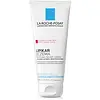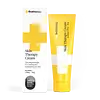What's inside
What's inside
 Key Ingredients
Key Ingredients

 Benefits
Benefits

 Concerns
Concerns

 Ingredients Side-by-side
Ingredients Side-by-side

Colloidal Oatmeal 1%
AbsorbentWater
Skin ConditioningButyrospermum Parkii Butter
Skin ConditioningGlycerin
HumectantDimethicone
EmollientParaffinum Liquidum
EmollientNiacinamide
SmoothingCetearyl Alcohol
EmollientBrassica Napus Seed Oil
EmollientAmmonium Polyacryloyldimethyl Taurate
Emulsion StabilisingPEG-100 Stearate
Glyceryl Stearate
EmollientTocopherol
AntioxidantSodium Benzoate
MaskingPEG-20 Methyl Glucose Sesquistearate
EmulsifyingDimethiconol
EmollientMannose
HumectantXanthan Gum
EmulsifyingPentaerythrityl Tetra-Di-T-Butyl Hydroxyhydrocinnamate
AntioxidantCapryloyl Glycine
CleansingMicrocrystalline Wax
Emulsion StabilisingSorbitan Tristearate
EmulsifyingParaffin
PerfumingDisodium EDTA
Vitreoscilla Ferment
Skin ConditioningCitric Acid
BufferingColloidal Oatmeal 1%, Water, Butyrospermum Parkii Butter, Glycerin, Dimethicone, Paraffinum Liquidum, Niacinamide, Cetearyl Alcohol, Brassica Napus Seed Oil, Ammonium Polyacryloyldimethyl Taurate, PEG-100 Stearate, Glyceryl Stearate, Tocopherol, Sodium Benzoate, PEG-20 Methyl Glucose Sesquistearate, Dimethiconol, Mannose, Xanthan Gum, Pentaerythrityl Tetra-Di-T-Butyl Hydroxyhydrocinnamate, Capryloyl Glycine, Microcrystalline Wax, Sorbitan Tristearate, Paraffin, Disodium EDTA, Vitreoscilla Ferment, Citric Acid
Water
Skin ConditioningHoney
HumectantStearyl Alcohol
EmollientCoco-Caprylate
EmollientStearic Acid
CleansingCaprylic/Capric Triglyceride
MaskingIsoamyl Laurate
EmollientGlyceryl Behenate
EmollientTapioca Starch
Olea Europaea Fruit Oil
MaskingCetyl Palmitate
EmollientGluconolactone
Skin ConditioningGlyceryl Stearate Citrate
EmollientBehenyl Alcohol
EmollientSorbitan Palmitate
EmulsifyingSorbitan Olivate
EmulsifyingButyrospermum Parkii Butter
Skin ConditioningBetaine
HumectantAroma
Xanthan Gum
EmulsifyingJojoba Esters
EmollientHelianthus Annuus Seed Oil
EmollientAminomethyl Propanol
BufferingAleurites Moluccanus Seed Oil
Skin ConditioningSodium Benzoate
MaskingPolyglyceryl-6 Caprylate
EmulsifyingPolyglyceryl-3 Cocoate
EmulsifyingPolyglyceryl-6 Ricinoleate
EmulsifyingPolyglyceryl-4 Caprate
EmulsifyingVanilla Planifolia Fruit Extract
Skin ConditioningLavandula Hybrida Oil
EmollientLavandula Angustifolia Oil
MaskingMentha Piperita Oil
MaskingPotassium Sorbate
PreservativeGlyceryl Caprylate
EmollientCaprylhydroxamic Acid
Pongamia Glabra Seed Oil
Skin ConditioningPanthenol
Skin ConditioningGlycerin
HumectantPolyglyceryl-3 Polyricinoleate
EmulsifyingRosmarinus Officinalis Leaf Extract
AntimicrobialBisabolol
MaskingCalcium Gluconate
HumectantTocopherol
AntioxidantWater, Honey, Stearyl Alcohol, Coco-Caprylate, Stearic Acid, Caprylic/Capric Triglyceride, Isoamyl Laurate, Glyceryl Behenate, Tapioca Starch, Olea Europaea Fruit Oil, Cetyl Palmitate, Gluconolactone, Glyceryl Stearate Citrate, Behenyl Alcohol, Sorbitan Palmitate, Sorbitan Olivate, Butyrospermum Parkii Butter, Betaine, Aroma, Xanthan Gum, Jojoba Esters, Helianthus Annuus Seed Oil, Aminomethyl Propanol, Aleurites Moluccanus Seed Oil, Sodium Benzoate, Polyglyceryl-6 Caprylate, Polyglyceryl-3 Cocoate, Polyglyceryl-6 Ricinoleate, Polyglyceryl-4 Caprate, Vanilla Planifolia Fruit Extract, Lavandula Hybrida Oil, Lavandula Angustifolia Oil, Mentha Piperita Oil, Potassium Sorbate, Glyceryl Caprylate, Caprylhydroxamic Acid, Pongamia Glabra Seed Oil, Panthenol, Glycerin, Polyglyceryl-3 Polyricinoleate, Rosmarinus Officinalis Leaf Extract, Bisabolol, Calcium Gluconate, Tocopherol
Ingredients Explained
These ingredients are found in both products.
Ingredients higher up in an ingredient list are typically present in a larger amount.
This ingredient is also known as shea butter. It is an effective skin hydrator and emollient.
Emollients help soothe and soften your skin. It does this by creating a protective film on your skin. This barrier helps trap moisture and keeps your skin hydrated. Emollients may be effective at treating dry or itchy skin.
Shea butter is rich in antioxidants. Antioxidants help fight free-radicals, or molecules that may harm the body. It is also full of fatty acids including stearic acid and linoleic acid. These acids help replenish the skin and keep skin moisturized.
While Shea Butter has an SPF rating of about 3-4, it is not a sunscreen replacement.
Shea butter may not be fungal acne safe. We recommend speaking with a professional if you have any concerns.
Learn more about Butyrospermum Parkii ButterGlycerin is already naturally found in your skin. It helps moisturize and protect your skin.
A study from 2016 found glycerin to be more effective as a humectant than AHAs and hyaluronic acid.
As a humectant, it helps the skin stay hydrated by pulling moisture to your skin. The low molecular weight of glycerin allows it to pull moisture into the deeper layers of your skin.
Hydrated skin improves your skin barrier; Your skin barrier helps protect against irritants and bacteria.
Glycerin has also been found to have antimicrobial and antiviral properties. Due to these properties, glycerin is often used in wound and burn treatments.
In cosmetics, glycerin is usually derived from plants such as soybean or palm. However, it can also be sourced from animals, such as tallow or animal fat.
This ingredient is organic, colorless, odorless, and non-toxic.
Glycerin is the name for this ingredient in American English. British English uses Glycerol/Glycerine.
Learn more about GlycerinSodium Benzoate is a preservative. It's used in both cosmetic and food products to inhibit the growth of mold and bacteria. It is typically produced synthetically.
Both the US FDA and EU Health Committee have approved the use of sodium benzoate. In the US, levels of 0.1% (of the total product) are allowed.
Sodium benzoate works as a preservative by inhibiting the growth of bacteria inside of cells. It prevents the cell from fermenting a type of sugar using an enzyme called phosphofructokinase.
It is the salt of benzoic acid. Foods containing sodium benzoate include soda, salad dressings, condiments, fruit juices, wines, and snack foods.
Studies for using ascorbic acid and sodium benzoate in cosmetics are lacking, especially in skincare routines with multiple steps.
We always recommend speaking with a professional, such as a dermatologist, if you have any concerns.
Learn more about Sodium BenzoateTocopherol (also known as Vitamin E) is a common antioxidant used to help protect the skin from free-radicals and strengthen the skin barrier. It's also fat soluble - this means our skin is great at absorbing it.
Vitamin E also helps keep your natural skin lipids healthy. Your lipid skin barrier naturally consists of lipids, ceramides, and fatty acids. Vitamin E offers extra protection for your skin’s lipid barrier, keeping your skin healthy and nourished.
Another benefit is a bit of UV protection. Vitamin E helps reduce the damage caused by UVB rays. (It should not replace your sunscreen). Combining it with Vitamin C can decrease sunburned cells and hyperpigmentation after UV exposure.
You might have noticed Vitamin E + C often paired together. This is because it is great at stabilizing Vitamin C. Using the two together helps increase the effectiveness of both ingredients.
There are often claims that Vitamin E can reduce/prevent scarring, but these claims haven't been confirmed by scientific research.
Learn more about TocopherolWater. It's the most common cosmetic ingredient of all. You'll usually see it at the top of ingredient lists, meaning that it makes up the largest part of the product.
So why is it so popular? Water most often acts as a solvent - this means that it helps dissolve other ingredients into the formulation.
You'll also recognize water as that liquid we all need to stay alive. If you see this, drink a glass of water. Stay hydrated!
Learn more about WaterXanthan gum is used as a stabilizer and thickener within cosmetic products. It helps give products a sticky, thick feeling - preventing them from being too runny.
On the technical side of things, xanthan gum is a polysaccharide - a combination consisting of multiple sugar molecules bonded together.
Xanthan gum is a pretty common and great ingredient. It is a natural, non-toxic, non-irritating ingredient that is also commonly used in food products.
Learn more about Xanthan Gum